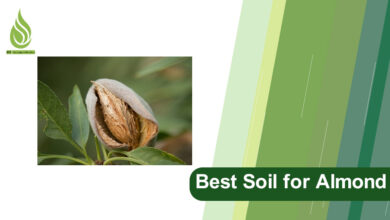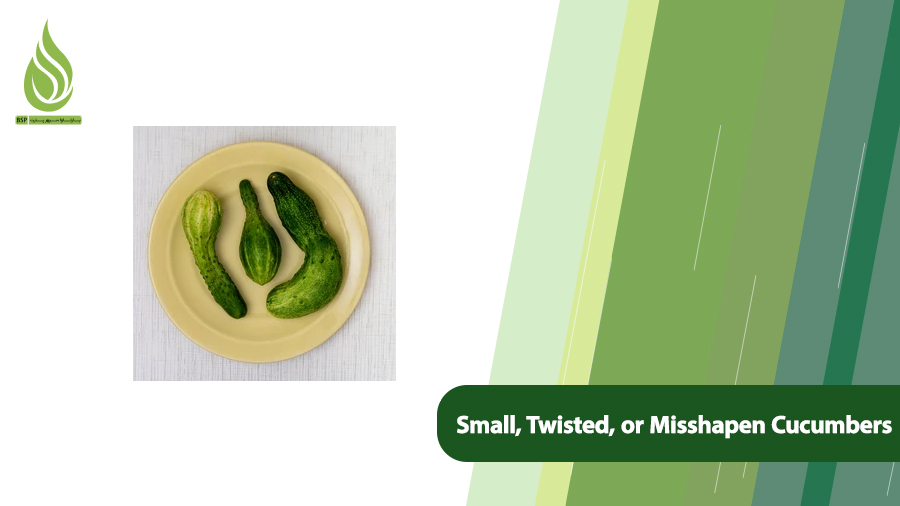
Why Are Cucumbers Small, Twisted, or Misshapen? + Solutions
Cucumbers are a staple in many diets, valued for their refreshing, crisp texture and versatility. Whether sliced into salads, pickled, or enjoyed fresh, cucumbers are a favorite among consumers and a profitable crop for farmers. However, achieving high-quality cucumbers, those that are straight, well-sized, and visually appealing, requires careful attention to growing conditions. Unfortunately, farmers and gardeners often encounter cucumbers that are small, twisted, or deformed, which can reduce their market value and lead to financial losses. In this detailed guide, we’ll explore the reasons behind these issues and provide practical, science-backed solutions to help you grow healthy, market-ready cucumbers.
Twisted or Misshapen Cucumbers Hurt Market Appeal!
When cucumbers are twisted, deformed, or undersized, they lose their appeal in the marketplace. Consumers typically prefer cucumbers that are long, straight, and uniformly shaped, as these qualities signal freshness and quality. Misshapen or small cucumbers are often overlooked by buyers, leaving farmers with unsold produce and reduced profits. For small-scale farmers or home gardeners, this can be especially disheartening after months of hard work—from preparing the soil to nurturing plants through the growing season.
Consider a farmer who spends weeks tending to their cucumber crop, only to find that half of the harvest is twisted or too small to sell at the local market. This not only impacts their income but also their reputation as a reliable supplier. By understanding the causes of these issues and implementing proper cultivation practices, growers can produce cucumbers that meet consumer expectations. For example, restaurants and grocery stores often have strict standards for produce, and consistently delivering high-quality cucumbers can secure long-term buyers and better prices. Let’s explore the root causes of small, twisted, or misshapen cucumbers and how to prevent them.
Why Do Cucumbers Stay Small?
Small cucumbers are a common frustration for growers, signaling that something is preventing the fruit from reaching its full potential. This issue often stems from nutritional deficiencies, environmental stress, or improper care during critical growth stages. Below are the primary reasons why cucumbers remain small, along with detailed explanations and examples:
- Inadequate Nutrition: Cucumbers require a balanced supply of nutrients to grow properly. Deficiencies in key elements like potassium and phosphorus can stunt fruit development. For instance, potassium supports cell expansion and water uptake, which are essential for cucumber size. A farmer who skips soil testing might unknowingly plant in nutrient-poor soil, resulting in undersized fruit. Regular soil tests can identify deficiencies early, allowing growers to apply targeted fertilizers. Example: A grower in California noticed that their cucumbers were consistently small. After a soil test revealed low potassium levels, they applied a potassium-rich fertilizer, resulting in larger, healthier cucumbers in the next harvest.
- Water Stress: Cucumbers are water-intensive crops, and inconsistent watering—especially during the fruiting stage—can halt growth. For example, if a farmer reduces irrigation during a hot summer week, the plants may experience stress, leading to smaller fruit. Drip irrigation systems deliver water directly to the root zone, ensuring steady moisture without waterlogging the soil. Example: A home gardener in Texas switched to drip irrigation after noticing small cucumbers. The consistent water supply led to a noticeable improvement in fruit size within weeks.
- Temperature Extremes: Cucumbers thrive in warm conditions (ideally 70–85°F), but extreme heat or cold can disrupt growth. High temperatures above 90°F can cause cucumber flowers drop, while cooler temperatures below 60°F slow metabolic processes, resulting in smaller fruit. Using shade cloth during heatwaves or row covers during cooler periods can help stabilize conditions. Example: A farmer in the Midwest used row covers during an unseasonably cool spring, protecting young cucumber plants and ensuring larger fruit later in the season.
- Incomplete Pollination: Outdoor-grown cucumbers rely on pollinators like bees to transfer pollen from male to female flowers. Incomplete pollination results in small, underdeveloped fruit or flower drop. Factors like pesticide overuse, lack of pollinator-friendly plants, or rainy weather can reduce bee activity. Encouraging pollinators by planting flowers like marigolds or allowing clover to grow nearby can improve pollination rates. Example: A grower in Oregon planted wildflowers near their cucumber field, attracting more bees and increasing fruit size and yield.
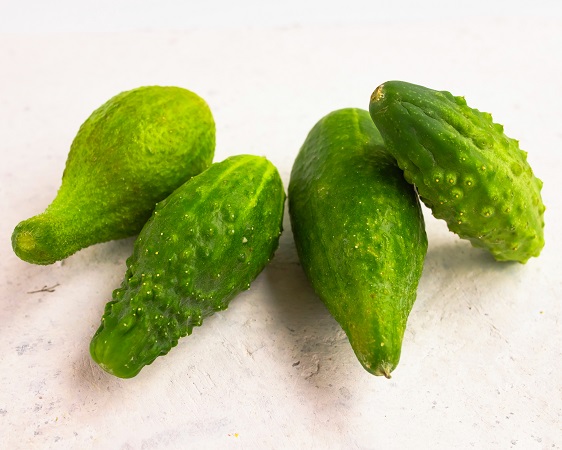
Why Are Cucumbers Twisted or Misshapen?
Twisted or misshapen cucumbers are often the result of environmental stress, pest damage, or improper care. These deformities make cucumbers less appealing to buyers and can indicate underlying issues in the growing process. Here’s a deeper look at the causes and real-world examples:
- Improper Watering: Inconsistent watering causes uneven growth, leading to twisted or cracked cucumbers. For instance, if plants receive ample water one week but are under-watered the next, the fruit may develop irregularly. Drip irrigation or soaker hoses provide a steady water supply, reducing stress. Overwatering, on the other hand, can cause waterlogged roots, leading to similar deformities. Example: A farmer in Florida noticed twisted cucumbers during a dry spell. After installing a drip irrigation system, the next crop produced straighter, more uniform fruit.
- Stress During Flowering and Fruit Formation: Environmental stressors like low light, extreme temperatures, or high humidity during flowering can distort cucumber shapes. For example, heavy shade from nearby trees can reduce photosynthesis, leading to weak fruit development. Mulching with straw or wood chips helps regulate soil moisture and temperature, minimizing stress. Example: A gardener in New York applied straw mulch around cucumber plants, stabilizing soil conditions and reducing twisted fruit in their harvest.
- Pests and Diseases: Insects like aphids, whiteflies, or spider mites suck sap from plants, weakening them and causing deformed fruit. Viral diseases, such as cucumber mosaic virus, can also lead to twisted or stunted cucumbers. Regular scouting and early intervention with neem oil or insecticidal soaps can control pests. For diseases, removing infected plants and using resistant varieties are key. Example: A grower in Georgia used neem oil to manage aphid infestations, preventing further fruit deformities and improving overall crop health.
- Nutrient Deficiencies: Lack of nutrients like calcium, potassium, or micronutrients (boron, zinc) can cause misshapen fruit. For instance, calcium deficiency leads to blossom-end rot, which distorts cucumber shape. Soil testing and balanced fertilization prevent these issues. Example: A farmer in Ohio conducted a soil test and applied a calcium supplement, eliminating spindle-shaped cucumbers in their next crop.
- Poor Pollination: Incomplete pollination often results in curved or misshapen cucumbers and even low cucumber yield. If pollinators are scarce, hand-pollination, using a small brush to transfer pollen, can ensure proper fruit development. Planting pollinator-friendly crops or maintaining beehives nearby can also help. Example: A small-scale grower in Virginia hand-pollinated their cucumbers during a rainy season when bee activity was low, resulting in straighter, healthier fruit.
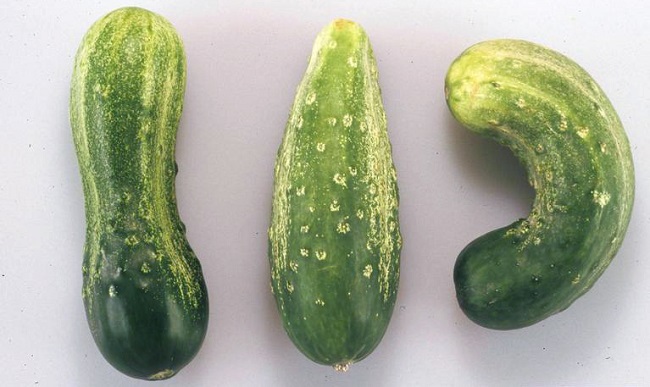
The Role of Fertilization in Cucumber Quality and Appearance
Proper fertilization is critical for producing high-quality cucumbers. Nutrient deficiencies or excesses can lead to deformed, small, or low-quality fruit. Conducting a soil test before planting helps identify nutrient needs and prevents common fertilization mistakes like over-fertilization. Here’s a detailed look at key nutrients and their impact:
- NPK Fertilizer: NPK fertilizers provide nitrogen, phosphorus, and potassium. Nitrogen promotes leafy growth, phosphorus supports root and flower development, and potassium enhances fruit quality. An NPK ratio like 10-10-10 is often suitable for cucumbers.
- Nitrogen: Nitrogen is essential for early plant growth, but excessive use during fruiting can lead to small, low-quality cucumbers. At the same time, low Nitrogen can cause leaf yellowing or even fruit yellowing. Apply nitrogen early in the season and reduce it during flowering. Example: A grower in Arizona reduced nitrogen applications during fruiting, resulting in larger, more flavorful cucumbers.
- Potassium: Potassium improves fruit size and shape. Deficiency causes short, club-like cucumbers. Apply potassium-rich fertilizers like potassium sulfate during fruiting.
- Calcium: Calcium prevents blossom-end rot and spindle-shaped fruit. Foliar sprays or soil amendments like gypsum can address deficiencies.
- Micronutrients: Boron, zinc, and iron are critical for uniform fruit growth. Deficiency symptoms include corky skin or cracks. Liquid micronutrient fertilizers can correct these issues. Example: A farmer in Wisconsin applied a boron supplement, eliminating twisted cucumbers caused by micronutrient deficiency.
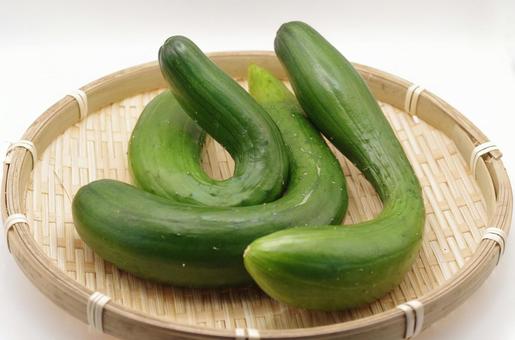
Solutions: How to Grow Healthy, Well-Shaped Cucumbers
To prevent small, twisted, or misshapen cucumbers, growers must address environmental, nutritional, and pest-related factors. Here are detailed, actionable solutions:
- Ensure Adequate Watering: Maintain consistent soil moisture with drip irrigation or soaker hoses. Check soil daily during hot weather to prevent drying out.
- Proper Nutrition: Use soil tests to guide fertilization. Apply balanced NPK fertilizers and supplement with calcium or micronutrients as needed.
- Control Environmental Conditions: Plant cucumbers in full sun with good air circulation. Use mulch to regulate soil temperature and moisture.
- Pest and Disease Management: Scout for pests weekly and use organic controls like neem oil for early infestations. Remove diseased plants to prevent the spread of viruses.
- Choose Resistant Seeds: Select cucumber varieties bred for disease resistance and uniform growth, such as ‘Marketmore’ or ‘Diva.’
- Proper Plant Spacing: Space plants 12–18 inches apart to reduce competition and ensure healthy growth.
By implementing these strategies, growers can produce cucumbers that are crisp, well-formed, and ready for market. Consistent care and attention to detail will yield a bountiful, high-quality crop.
